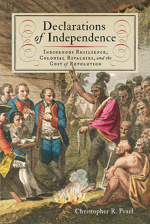Today, we are happy to bring you our conversation with Christopher R. Pearl, author of Declarations of Independence: Indigenous Resilience, Colonial Rivalries, and the Cost of Revolution
What inspired you to write this book?
My inspiration for this book came from teaching early American history at a small college situated on the West Branch of the Susquehanna River, an area with a rich past that's often distorted. Local historical narratives/folklore from this area are predominantly settler centric, revolving around a group of squatters, the “Fair Play men,” “hardy pioneers” who formed their own squatter republic and supposedly declared their independence on July 4, 1776 (at the same time as Congress, but completely unaware). Not only is that story rather fantastical, but such a focus sidelines the significant role of Indigenous peoples in that same story. Those “pioneers,” after all, were squatting on Indigenous land. I wanted to write a book that challenges these myths while also highlighting the central place of Indigenous nations in this “founding” story. By doing so, I try to offer a more accurate and, I hope, inclusive account of the American Revolution in the Northern Susquehanna River Valley.
What did you learn and what are you hoping readers will learn from your book?
I hope readers gain a greater appreciation for the importance of land and generational grievances in shaping the diverse experiences of the revolutionary era, influencing both the causes and costs of the American Revolution for everyone involved, even those far from the Northern Susquehanna River Valley. As I researched and wrote this book, I learned a lot about the power of land in shaping motivations across generations. We often view the American Revolution as confined to a specific period, often 1765-1783, demarcated by events such as the Stamp Act and the Treaty of Paris, but generational grievances, knowledge, and memories extend well beyond either side of that period and those events. In Declarations of Independence, I tried to reimagine that timeline to include not just rebellious squatters but the Susquehanna Nations, a collection of diverse Native nations who also declared their independence. Such a focus necessarily required highlighting different events or moments within and beyond the typical revolutionary periodization. I hope readers will walk away with the knowledge of other critical events or moments that defined the revolutionary era, seeing how the past reverberates, shaping historical actors and actions up to the present moment.
What surprised you the most in the process of writing your book?
What surprised me most was just how important the Northern Susquehanna River Valley, particularly the West Branch of the Susquehanna River was to the American Revolution. I originally set out to write about this specific area and historicizing its local myths during the Revolution, but I quickly realized the area’s history had wider implications. Initially, I assumed only regions like the Ohio River Valley had broader more meaningful significance, and therefore what I was doing felt relatively insignificant. However, as I researched and wrote this book, I discovered that the events in the Northern Susquehanna River Valley had far-reaching consequences that shaped early American history in ways I hadn't imagined. The result is a book that goes beyond an interesting local story to reveal a profoundly American one.
What’s your favorite anecdote from your book?
This is a tough question because "favorite" often suggests something joyful. My favorite anecdote is eye-opening rather than happy. One critical group I write about is the "Fair Play men," but getting at their motivations was challenging. I sifted through scattered records like land office files, court documents, petitions, missionary accounts, tax records, newspapers, and broadsides, but those documents never quite revealed any one individual’s voice or rationale. Eventually, I found that more than a few of those squatters applied for Revolutionary War pensions where they had to tell those individual stories. Robert Hamilton, for instance, who squatted on that land and also served in the Fair Play government, applied for a pension in the 1830s, then his widow, Anna Jackson along with her son, John, kept up the request, writing of Robert’s service, and what is more, their own experiences of the Revolution, which they called “the late unhappy Indian war.” These narratives were extremely revealing. John, for instance, taking up the cause right after his father’s death, recounted his father’s “patriotism” by highlighting his participation in declaring independence on July 4, 1776 “on the banks of Pine Creek,” and shockingly, in the very next sentence, revealed “I have often heard my father say that in those exciting times he had a great desire to kill an Indian.” For John, his father’s participation in the Pine Creek declaration and this disturbing sentiment were intertwined in any explanation of his dedication to “liberty and patriotism.” That was a vision of the Revolution expressed throughout the other documents as well as each one of the pension applications of the other Fair Play squatters. This anecdote and those like it pushed me to explore the complex and sometimes dark motivations of the Fair Play squatters, shaping the focus of my book to understand how and why such motivations existed at all. In the process, the Susquehanna Nations came into sharper focus. Their push for independence, which precipitated such settler visions of the Revolution was just if not more significant to the creation of the United States. Declarations of Independence attempts to shift focus away from just a settler colonial design to the agency and resilience of Native peoples and nations who consistently resisted and defined the parameters of settler desires as well as the meaning of the American Revolution itself, shaping the founding of the United States.
What’s next?
I'm really excited about what comes next. I have a germ of an idea that came out of the research for this book. In the conclusion of Declarations of Independence, titled "Aftermath," I share a revealing anecdote from the early 1790s. Descendants of the Fair Play squatters, sons of Revolutionary veterans and veterans themselves, committed a shocking act of violent “retribution.” They murdered two innocent Seneca men who were hunting on land they had hunted on for generations but was now claimed by those Fair Play descendants as the spoils of the Revolutionary War. Later, the perpetrators alleged the two Seneca men had a role in their father's death during the Revolutionary War (though the evidence for that connection is specious), which they thought justified their actions. The local community agreed and found common cause with the perpetrators, shielding them from a federal investigation and state prosecution. Despite President George Washington's intervention, who feared a renewed conflict with the Seneca because of the murders, the community's actions challenged his administration, shaping diplomatic relations with Indigenous nations for generations. Like in Declarations of Independence, I want to explore this story from multiple angles to reveal its broader implications for the early development of the United States.





